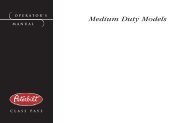MODEL 330 OPERATOR'S MANUAL - Peterbilt Motors Company
MODEL 330 OPERATOR'S MANUAL - Peterbilt Motors Company
MODEL 330 OPERATOR'S MANUAL - Peterbilt Motors Company
You also want an ePaper? Increase the reach of your titles
YUMPU automatically turns print PDFs into web optimized ePapers that Google loves.
Preventive Maintenance<br />
Tires and Wheels<br />
Tire Inspection and Replacement<br />
Visually inspect your tires frequently for any abnormal conditions<br />
such as scrapes, bulges, and uneven wear. This must<br />
be done immediately after known or suspected contact with<br />
an object in the road, with a pothole, road irregularity or after<br />
severe braking. Refer these conditions to an Authorized Tire<br />
Service Center for repair or replacement. Never drive on a<br />
tire if such conditions appear.<br />
If the tire looks underinflated, stand off to the side and check<br />
for damage to the wheel assembly. This can be done by visually<br />
comparing the wheel in question to other wheels on the<br />
vehicle. For dual wheel assemblies, check between the<br />
wheels for damage. If any damage is found, or you suspect<br />
damage, do not attempt further repair. Call for expert tire service.<br />
Tire Inflation and Loading<br />
Low pressure is a tire’s worst enemy. Underinflation allows<br />
tires to flex improperly, causing high temperatures to build up.<br />
Heat causes early tire damage such as flex break, radial<br />
cracks, and ply separation. And low pressure may affect control<br />
of your vehicle, especially at the front wheels.<br />
Tire Inflation<br />
WARNING! Do not operate vehicle with underinflated<br />
tires. The extra heat caused by underinflation<br />
can cause sudden tire failure such as a tire<br />
fire or blow out. Low pressure may affect control<br />
at the front wheels, which could result in an accident<br />
and serious injury. Keep your tires inflated<br />
to the manufacturer’s recommended air pressure.<br />
Most tire wear problems are caused by underinflation as the<br />
result of slow leaks. So you will want to check tire pressure<br />
regularly. Give the tires a visual test every day, and check<br />
inflation with a gauge every week.<br />
When checking tire pressure, inspect each tire for damage to<br />
sidewalls, cuts, cracks, uneven wear, rocks between dual<br />
wheels (tires), etc. If a tire appears underinflated, check for<br />
Model <strong>330</strong> PB1318 3/01 – 173 –
















